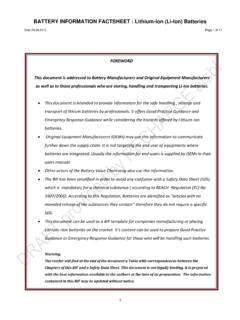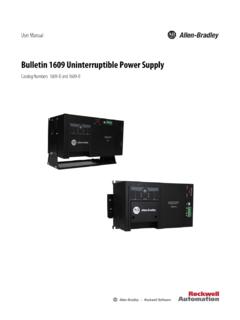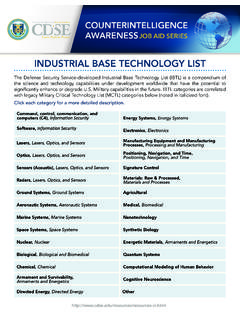Transcription of Safety of Lithium ion batteries - RECHARGE
1 Safety of Lithium -ion batteries June 2013 The European Association for Advanced Rechargeable batteries Safety of Lithium -ion batteries 1 Foreword This publication is prepared to provide information regarding the subject matter covered. The document has been prepared with the information available at the time of its publication. It is communicated with the understanding that the authors are not engaged in rendering legal or other professional services on issues covered by this report.
2 Authors. This publication has been prepared by RECHARGE aisbl. The membership of RECHARGE includes suppliers of primary and secondary raw materials to the battery industry, rechargeable battery manufacturers, original equipment manufacturers, logistics partners and battery recyclers. RECHARGE is following the continuously changing regulatory and legislative environment for rechargeable batteries and is a recognized expertise centre for advanced portable and industrial rechargeable battery technologies. RECHARGE aisbl Avenue de Tervueren, 168.
3 B-3. B-1150 Brussels. Belgium. Contacts. C. Chanson. General Manager. J-P Wiaux. Director General. Copyright 2013 by RECHARGE aisbl Safety of Lithium -ion batteries 2 Content 1. Executive Summary 2. Introduction 3. Lithium -ion batteries : key features Market and Applications Chemistry and Technology 4 Lithium -ion battery hazards The type of hazards Root causes of a thermal run-away Hazards effects/consequences 5. Lithium -ion battery Safety management Safety management approach Safety standards Safety management tools 6.
4 Conclusions Safety of Lithium -ion batteries 3 1. Executive Summary Lithium -ion battery Safety has raised a large interest in the public in the recent years. This battery technology has been finding new markets since the years 2000. It is associated with the market development of cordless communication technologies and equipment such as cellular phones and portable computers, power tools and more recently tablets. In Europe it is the preferred battery technology for e-bikes, it is expected in the near future to be widely used in Plug-In Hybrid and full Electric Vehicles.
5 The number of rechargeable Lithium -ion batteries used in cordless applications is well above one billion units per year and it is expected to grow in the mid-term. Despite the high Safety standards used in the production of these batteries , several incidents have been reported, raising questions about the Safety of this technology. The aim of this document is to describe the risks associated with this technology, and how they are managed in order to guarantee a safe use of Lithium -ion batteries .
6 The following conclusions are drawn from this study. 1. The Safety protection is a fundamental function integrated in a Lithium -ion battery, minimizing the occurrence of the flammability hazard and its consequences by a combination of prevention, protection and mitigation systems: Prevention and protection includes electronic protections, mechanical design and electric design incorporating the necessary redundancies to ensure the reliability of the Safety protection: current and voltage control, state of charge and temperature Mitigation systems reduce the consequences of defaults or abuse, internal shorts, temperature elevation, excess current, mechanical damage, through the usage of Safety vents, heat protection or evacuation systems, mechanical 2.
7 Product compliance with well established international or private standards validate that the Safety protection is adapted to the intended use. In addition, Lithium -ion batteries have to be qualified for transport according to a UN Safety standard, requiring manufacturers to comply with Safety Test requirements and a Quality Management System. 3. The global approach to the hazard management has made the Lithium -ion battery one of the safest energy storage systems. Billions of electrical and electronic equipments powered by these batteries are used worldwide on a daily basis confirming that the Safety of Lithium -ion batteries is well managed.
8 4. The major hazard offered by Lithium -ion battery technologies is the evolution of a fire, as a result of the flammability of the substances used in the battery. A large majority of incidents reported recently found their origin in the following: Non-respect of UN provisions and packaging requirements prior to the transport of Lithium -ion batteries . Cells assembly by non-professionals for innovative applications. Concentration of Lithium -ion cells in non-controlled storage conditions or areas. The Lithium -ion battery Industry and RECHARGE are working at various levels of International and National Institutions to improve and guarantee the Safety of Lithium -ion batteries during use and transport while this battery technology is undergoing a strong market development.
9 Safety of Lithium -ion batteries 4 2. Introduction A Lithium -ion battery is an electrochemical device optimized to store and release energy in the context of a specific application. All energy storage systems, whatever the system used, have a risk of unexpected environmental conditions or defaults which could create an accidental or uncontrolled energy release. Specific environmental conditions are often used to test and characterize the stability of the energy storage system, defining the frontier between the acceptable conditions of use and the abusive conditions.
10 In case of accidental abusive conditions or defaults producing some potential hazard occurrence, mitigations measures can be taken to avoid hazardous consequences. Using this information, products can be designed to control their Safety with appropriate means both for the risk prevention and for the consequences mitigation while controlling any hazardous event during normal usage. Table 1 below is describing some examples for different energy storage systems and the type of hazard they can offer.






